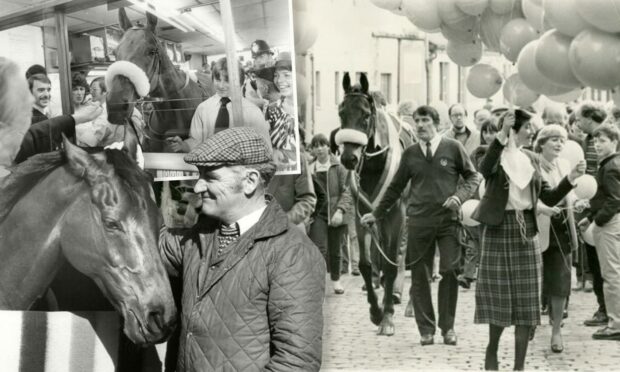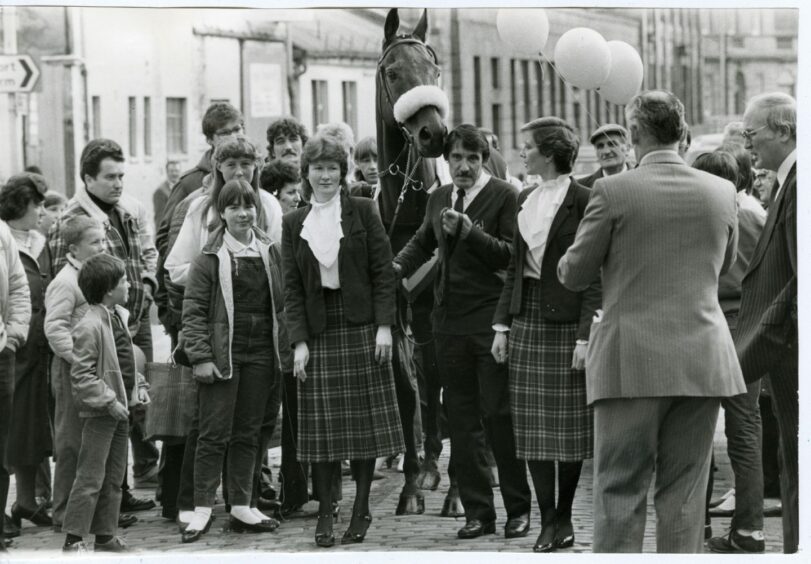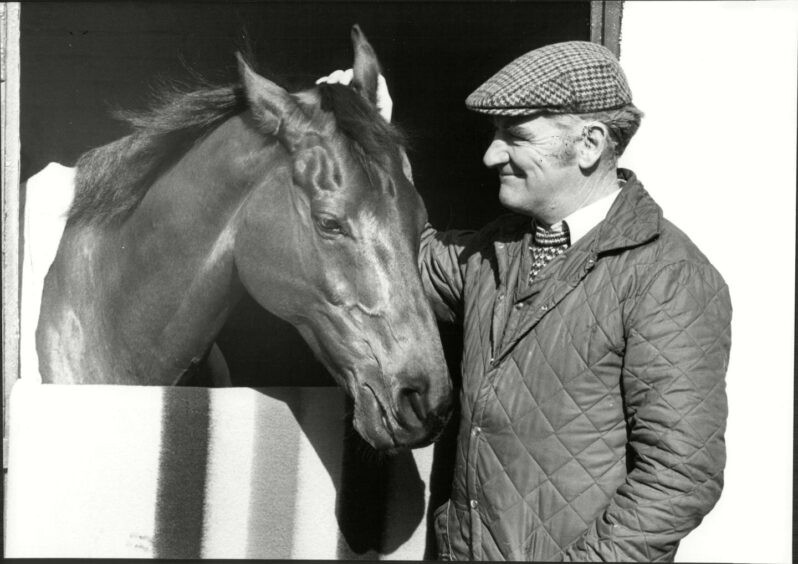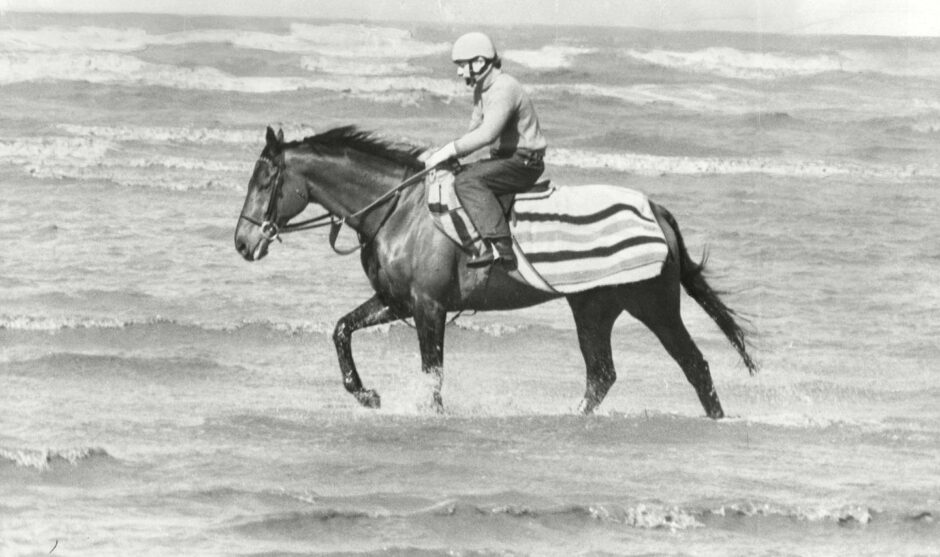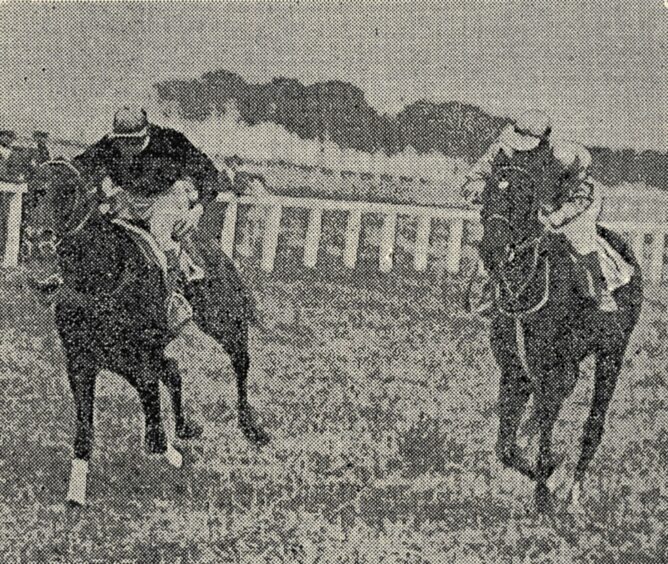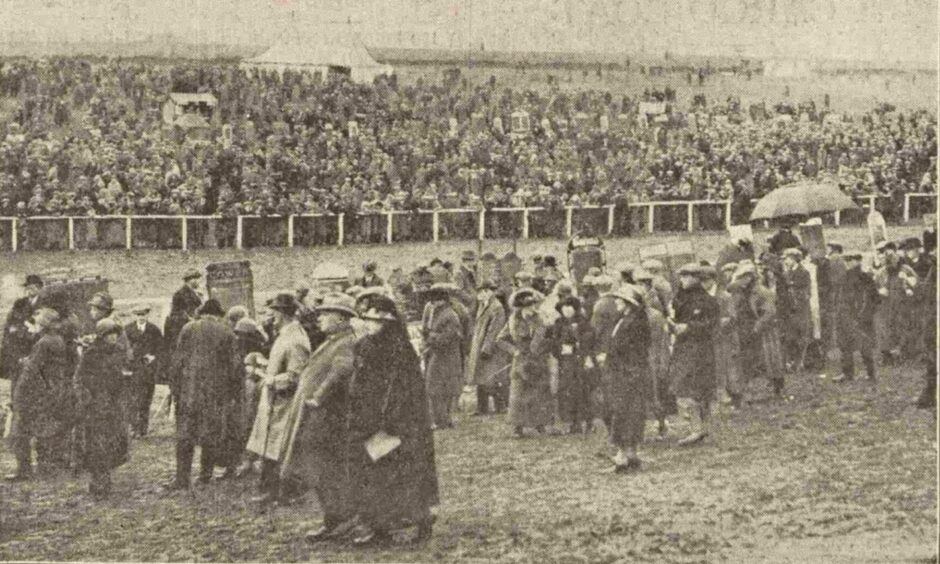Red Rum proved he was the people’s champion when he stopped traffic after taking to the streets of Dundee in 1982.
People were hanging out of windows to catch a glimpse of the three-time Grand National winner during his canter through the city centre.
Rummy spent the night at stables in Invergowrie before travelling to Dundee where he was making a public appearance at the William Hill betting shop.
Like a human celebrity, he travelled in style and comfort, in a luxury horsebox, built and gifted by Chrysler, with its own air conditioning system.
He was surrounded by children and balloons during his walkabout before making his way to the betting shop where beauty queen Elaine Ruse made a £50 charity wager.
Red Rum was a hero among horses, an athlete, a character, an extrovert and a crowd pleaser, who inspired artists, musicians and fashion designers.
Tim Molony bought Red Rum as a yearling for 400 guineas in 1966 and won his first race at Aintree the following March.
He was passed around several owners before Southport car dealer Donald ‘Ginger’ McCain bought him for his client Noel le Mare in 1972.
It was a partnership made in heaven.
It wasn’t apparent at the time, but Rummy was suffering from a bone disease in his foot and he appeared lame when McCain initially trotted the horse.
Again fate stepped in.
Red Rum was at probably the only yard in the country where training took place on a beach and the sea water worked an amazing transformation.
He won his first five races for his new trainer and was 9/1 favourite when jockey Brian Fletcher brought him to post for the 1973 Grand National.
Red Rum broke all records by winning the National three times, in 1973, 1974 and 1977, and finishing second in the intervening years.
He might have won again in 1978 had he not had to retire on the eve of the National because of an injured leg.
In retirement, the horse that had become a racing institution became an industry.
People and organisations all over Britain wanted Red Rum to make their day, and their occasion, by putting in a personal appearance.
Red Rum inspired musicians, too.
Keith Parrott recorded The Red Rum Song in 1979, while the horse contributed snorts and hoofbeats on another song recorded by Christopher Robin and Ted and Alice.
Even the coat on Rummy’s back had star appeal.
Clippings from his coat were woven into exclusive cloth that was turned into hacking jackets, with the first one made selling for £500.
Even when McCain, mindful of the advancing years, began to cut down on his engagements, it only resulted in people offering to double their fees.
When Rummy died aged 30 in 1995, he was buried at the Aintree winning post and a statue in his honour was erected.
Dundee windfall
Brian King, author of Rediscovered Dundee, said Red Rum’s September 1982 visit was not the first time a Grand National winner has put a smile on people’s faces in the city.
“Every time the race is run it seems to produce an interesting story but one of the most memorable took place on April 8 1967,” said Brian.
“At the 23rd fence, a loose horse called Popham Down lived up to its name, helping to cause a pile-up of many of the competitors who had made it thus far.
“One hitherto unfancied horse, Foinavon, was so far behind that it did not get involved in the melee, jumped the fence cleanly and went on to win the Grand National at 100/1.”
Although 17 jockeys remounted and some made up considerable ground, particularly Josh Gifford on favourite Honey End, none had time to catch Foinavon.
The fence was officially named the Foinavon Fence in 1984.
Brian said: “There were stories that this produced a windfall for some residents of the Fintry housing scheme who lived in or near the similarly named Finavon Street, Place or Terrace, and had decided to have a punt on the basis of a name.
“A similar thing happened in 1928 when 10-year-old outsider Tipperary Tim had been the only horse which did not fall, bringing delight to people living in the Irish district of Lochee, centred on Atholl Street, which was nicknamed Tipperary.”
Before the 1928 race began, jockey William Dutton heard a friend call out to him: “Billy boy, you’ll only win if all the others fall down!”
Longhaugh races
These words turned out to be prophetic, as 41 of the 42 starters fell.
Tipperary Tim came in first at 100/1.
Only two riders completed the course, a record for the lowest number of finishers.
“A few years before Tipperary Tim romped home, and not far from where the Fintry winners of 1967 lived, Dundee briefly had its own racecourse at Longhaugh,” said Brian.
“The flat racing course included a grandstand which was built on concrete foundations and had space for 800 people.
“The inaugural two-day race meeting in April 1924 was a great success and attended by a total of 30,000 people.”
The prize money for Dundee’s inaugural meeting amounted to £450 and more than 50 horses were entered in the five races along the mile-long flat track.
Crowds arranged themselves along the railings bordering the course and cheered the horses as they galloped past and the general din was described as “almost deafening”.
A newspaper report at the time said “ladies indulged freely in flutters, some of them backing their favourites with quite substantial sums”.
But a number of bookies were noted to have packed up a bit too punctually with punters making “a frantic scramble in search of their winnings”.
Race meetings were held in July and October that year but attracted small crowds and Dundee Meetings Ltd went into liquidation in March 1925 and the land was sold off.
The course took in part of Longhaugh Road, went through what was a former school playground and ended with a finishing straight close to the line of Longhaugh Terrace.
No trace of it remains today.
More like this:
Alex Higgins, Steve Davis and the Arbroath bookie who cost the Hurricane a grand
